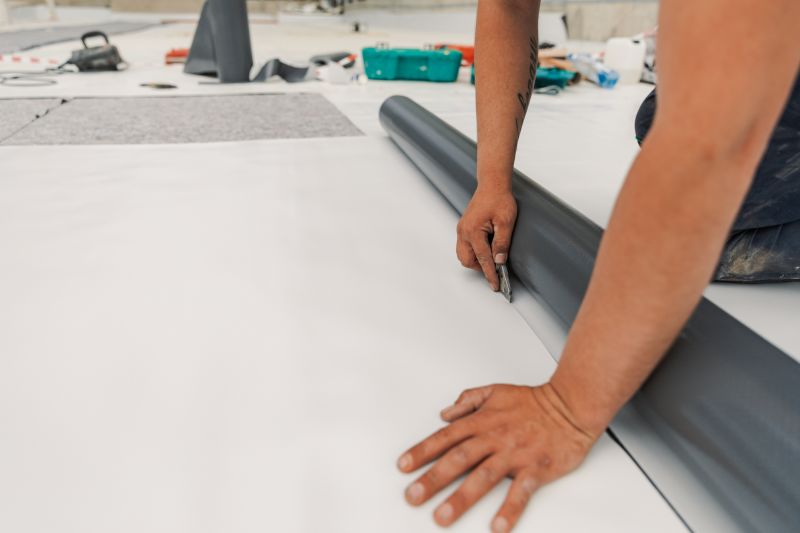Leading Solutions For Thermoplastic Roof Installation Projects
Explore innovative products and accessories that support a smooth and successful thermoplastic roof installation process.
 Thermoplastic roof installations are a popular choice for flat and low-slope roofing projects due to their durability, flexibility, and ease of installation. These systems typically involve the use of thermoplastic membranes that can be heat-welded together, creating a seamless and watertight barrier. The versatility of thermoplastic materials allows for a range of applications, from commercial buildings to residential flat roofs. When selecting products for thermoplastic roof installations, it is important to consider the compatibility of materials, ease of application, and long-term performance expectations.
Thermoplastic roof installations are a popular choice for flat and low-slope roofing projects due to their durability, flexibility, and ease of installation. These systems typically involve the use of thermoplastic membranes that can be heat-welded together, creating a seamless and watertight barrier. The versatility of thermoplastic materials allows for a range of applications, from commercial buildings to residential flat roofs. When selecting products for thermoplastic roof installations, it is important to consider the compatibility of materials, ease of application, and long-term performance expectations.
Top Overall Option
Thermoplastic Membrane Roofing System
A versatile thermoplastic membrane roofing system offers a flexible, durable, and seamless waterproofing solution suitable for various flat roof applications. It is designed for compatibility with heat welding techniques, ensuring strong, long-lasting seams. When paired with quality accessories and proper installation, it can provide reliable performance over time.
Types of Products For Thermoplastic Roof Installations
Thermoplastic Polyolefin (TPO) Membranes
A popular choice due to its flexibility and ease of installation, TPO membranes are suitable for a wide range of flat roof applications.
Polyvinyl Chloride (PVC) Membranes
Known for their chemical resistance and durability, PVC membranes are often used in commercial roofing projects.
Heat-Welding Equipment
Specialized tools designed to fuse thermoplastic seams securely, ensuring waterproof integrity.
Seam Rollers and Hand Tools
Tools used to press and smooth seams during installation, promoting adhesion and seam strength.
Reinforcement Fabrics
Fabric materials used to reinforce seams and protect vulnerable areas of the membrane.
Adhesives and Sealants
Products used to bond membranes to substrates and seal overlaps or penetrations.
Surface Preparation Materials
Cleaning and priming agents to prepare surfaces for optimal membrane adhesion.
Insulation Boards
Insulation layers that improve energy efficiency and provide a suitable base for membrane installation.
Edge and Termination Bars
Metal or plastic components used to secure membrane edges and prevent uplift.
Drainage Accessories
Components designed to facilitate water runoff and prevent ponding on flat roofs.
Vapor Barriers
Materials used to control moisture movement and protect the roofing assembly.
Fasteners and Anchors
Mechanical fasteners for securing insulation and membrane systems to the roof deck.
Protective Coatings
Coatings applied over membranes for additional protection against UV and physical damage.
Popular Choices
Widely used for their ease of installation and flexibility, TPO membranes are favored in many flat roof projects.
Known for chemical resistance and longevity, PVC membranes are a common choice for commercial roofs.
Essential for creating seamless, waterproof joints in thermoplastic roofing systems.
Used to strengthen seams and vulnerable areas within the membrane system.
Crucial for bonding membranes and sealing penetrations or edges.
Primers improve adhesion of membranes to various substrates and surfaces.
Provide thermal insulation and create a stable base for membrane installation.
Components that secure membrane edges and prevent uplift or damage.
Help manage water runoff and prevent ponding on flat roofs.
Mechanical fasteners that secure insulation and membranes to the roof deck.
Applied over membranes for added UV resistance and physical protection.
The installation process often requires specialized equipment such as heat welders and seam rollers to ensure secure and airtight joints. Proper surface preparation is essential to maximize adhesion and prevent future leaks. Additionally, accessories like sealants, adhesives, and reinforcement fabrics are commonly used to enhance the integrity of the roofing system. Maintenance and inspection are vital to ensure the longevity of the installation, with regular checks for seam integrity and surface wear.
Choosing the right products involves understanding the specific requirements of the project, including climate considerations, building codes, and the roof's structural characteristics. Quality thermoplastic membranes are designed to withstand temperature fluctuations, UV exposure, and physical stress, making them suitable for demanding environments. When combined with appropriate installation tools and supplementary products, these systems can provide a reliable roofing solution with a relatively straightforward installation process. Proper product selection and professional installation can help ensure the roof performs as intended over its lifespan.
Key Buying Considerations
- Compatibility of membrane materials with existing roofing components.
- Climate and temperature fluctuations that may impact material performance.
- Ease of installation and availability of necessary tools and accessories.
- Long-term durability and resistance to UV exposure, physical stress, and weathering.
- Ease of seam welding and the quality of welds for waterproofing integrity.
- Compatibility of adhesives, primers, and sealants with the membrane material.
- Ease of surface preparation and the condition of the existing roof deck.
- Availability of reinforcement fabrics and other accessories for seam strengthening.
- Ease of maintenance and inspection over the lifespan of the roofing system.
- Compliance with local building codes and industry standards.
- Cost considerations, including initial investment and long-term performance.
- Compatibility with insulation and other roofing layers.
- Flexibility of the membrane for accommodating building movements.
- Availability of professional installation services or DIY options.
- Warranty options and manufacturer support.
